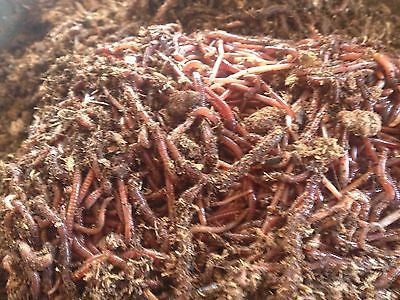Red Wiggler Worms - Enhance Your Soil Health And Wellness Normally
Red Wiggler Worms - Enhance Your Soil Health And Wellness Normally
Blog Article
Red Wiggler Worms Demystified: Unlocking the Tricks of Vermiculture for Greener Living and Nutrient-Rich Dirt
In the world of sustainable practices for improving dirt quality and advertising eco-conscious living, red wiggler worms play an essential yet often forgotten function. Red Wiggler Worms. Recognizing the details of caring for these worms, maximizing their atmosphere, and utilizing their spreadings can lead to a greener lifestyle and healthier dirt for plants to grow.
The Duty of Red Wiggler Worms
Red Wiggler worms play a crucial function in composting systems by effectively breaking down raw material into nutrient-rich spreadings. These ravenous eaters consume a selection of organic materials, such as cooking area scraps, yard waste, and paper products. As they feed, the worms' digestive procedures damage down the raw material right into a fine, dark, and nutrient-dense product referred to as worm spreadings or vermicompost.
The castings produced by Red Wiggler worms are extremely useful for dirt health and wellness and plant growth. They are abundant in crucial nutrients like nitrogen, potassium, and phosphorus, which are crucial for supporting healthy and balanced plant advancement. Furthermore, worm castings have beneficial germs and enzymes that assist enhance soil structure, boost water retention, and boost nutrient uptake by plants.
Benefits of Vermicomposting

It enhances soil framework, boosts soil oygenation, and boosts soil wetness retention. Vermicompost likewise improves the soil with vital nutrients like potassium, nitrogen, and phosphorus, advertising plant growth and general soil fertility.
In addition, vermicomposting supports sustainable horticulture practices by giving a chemical-free and all-natural alternative to artificial plant foods. Red Wiggler Worms. This ecologically pleasant strategy not just enriches the soil yet also helps lower dependence on unsafe chemicals, promoting a greener and a lot more sustainable means of horticulture
Establishing a Worm Container
When developing a worm bin for vermicomposting, correct configuration is crucial to make sure the success of the composting procedure. The initial step in setting up a worm container is choosing an appropriate container.
After adding the bedding, introduce the red wiggler worms to the bin. It is suggested to begin with a handful of worms and gradually increase as they increase. The worms need to after that be supplied with food scraps such as vegetables and fruit peels, coffee grounds, and eggshells. It is necessary to prevent adding meat, milk, oily, or salted foods to avoid attracting insects and producing unpleasant smells.
Routinely monitor the dampness degrees and temperature level in the worm bin to guarantee optimal problems for the worms. With correct setup and maintenance, the worm bin will efficiently convert organic waste right into nutrient-rich compost for your plants and garden.
Collecting Worm Spreadings
To successfully gather nutrient-rich worm castings from your vermicomposting system, a methodical harvesting method is vital. There are a few key steps to follow to make sure a successful procedure when it comes time to collect the worm spreadings. Quit adding fresh food scraps to one side of the worm container for a couple of weeks before collecting. This urges the worms to migrate to the side with fresh bed linen and food, making it easier to scoop out the spreadings from the opposite.

Troubleshooting Common Issues
Recognizing and addressing usual obstacles that might arise during the vermicomposting procedure is critical for maintaining a efficient and healthy worm container. One typical issue that vermicomposters encounter is overfeeding. Adding excess food scraps can result in a buildup of dampness and acidity in the worm container, possibly damaging the worms. To avoid this, feed the worms in moderation, making sure that the food scraps are properly damaged down prior to including a lot more. Another problem is unpleasant smells emanating from the worm bin. Foul scents suggest anaerobic problems, normally brought on by overwatering or insufficient air flow. To correct this, adjust the dampness degrees by adding completely dry bed linen materials like shredded newspaper or cardboard and rise oygenation by transforming the bedding routinely.
In addition, if the worm population is decreasing or the worms appear undesirable, maybe due to environmental stressors such as severe temperature levels or pH levels. Keeping track of these elements and making required modifications is important for the health of the worms. By troubleshooting these usual issues quickly, vermicomposters can make sure a effective and smooth vermicomposting procedure while preserving a flourishing click to read more worm population.

Verdict
In final thought, red wiggler worms play a vital function in vermiculture by damaging down raw material right into nutrient-rich soil. The benefits of vermiculture consist of greener living and enhanced dirt high quality. Establishing a worm container is vital for effective vermiculture, and harvesting worm spreadings provides important garden compost for gardening. By understanding and repairing typical issues, people can unlock the secrets of vermiculture for lasting living and healthier dirt.
As they feed, the worms' digestive system procedures break down the organic matter right into a fine, dark, and nutrient-dense product understood as worm spreadings or vermicompost.
The castings created by Red Wiggler worms are very helpful for dirt health and wellness and plant development. Including excess food scraps can lead to a build-up of dampness and acidity in the worm container, possibly harming the worms.Furthermore, if the worm populace is decreasing or the worms appear unhealthy, it could be due to environmental stressors such as extreme temperatures or pH degrees. Setting up a worm bin is essential for successful vermiculture, and harvesting worm spreadings provides important compost for gardening.
Report this page